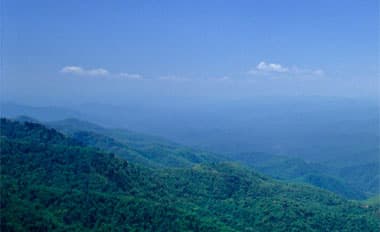Wood And Changes In The Weather
- December 7, 2012
- •
- by lwinkler
Wood is a “hygroscopic” material. Simply put, that means it freely gives off or takes on water as conditions around it change. Both wood and air have some amount of water in them. Water tends to move quite freely from the “wetter” of the two to the “drier.” Water in air is expressed as humidity, but because the amount of water air can hold varies with the temperature of the air, the percentage of water in the air at a given temperature is called relative humidity.
During extremely cold weather, air in the workplace or in a home or office is heated to a comfortable level. This increases the amount of water the air can hold, but unless moisture is simultaneously added does not change the amount of water actually in the air, thus decreasing the relative humidity. When relative humidity drops below 25% at a room temperature of 65 degrees F or higher, the air will seek moisture from other sources, and the most common source is, you guessed it, wood!
Warp is any deviation from a flat plane. In a hardwood plywood panel or component, that means that one or more corners of the panel or part will not touch a flat surface. Cupping (across the grain), bowing (parallel to the grain), and twisting (spiral to the grain) are all reported. In fabrication, this is usually observed as the panels are being sawn to component size. In the home or office, it is usually observed in free attached components such as doors or shelves.
The primary cause for warp is the dimensional change that takes place when wood gives off water as would be expected during the coldest, driest parts of the year when heating inside air is more likely. This is aggravated by the fact that wood gives off surface moisture first, thus leaving a mild to severe imbalance of moisture in the panel. Add to this the fact that one side of the panel or component is typically more protected than the other when panels are stacked with the face up or doors are mounted with one side facing the room and the other facing the inside of the cabinet.
Checks, also called splits or cracks, occur when dimensional change as a result of moisture movement described above creates stresses beyond the resistance capacity of the wood in question.
Checks usually occur parallel to the grain in species like maple or birch because this is where their weakest resistance to stress exists. Movement that takes place in the substrate directly under the face will not normally manifest itself by checking across the grain of the face, but in the case of highly ring porous woods like red oak or even ash, the checks may develop across the weaker areas of early growth (the coarse textured wood).
Ok, so how do we avoid warping and checking? There are many things that can be done, but the most important are:
- Ensure proper gluing instructions are followed
- Avoid lengthy warehouse time at the manufacturing facility
- Avoid lengthy delivery times
- Store wood in climate controlled warehouses at the distribution level and fabricator site
- Allow panels to acclimate to any new environment prior to processing
- Where possible, stack components face to face on uniform thickness pallets or runners and weight the stacks down with a reasonable weight between processes
- Maintain operating conditions between 30 and 60% relative humidity and 65 degrees to 75 degrees F in production and service
- Avoid installing any finished product on site until the heating and cooling systems are up and running, and even then allow the panels or finished goods to acclimate to the new environment before installing
- Seal all surfaces equally
- Allow for linear expansion in the design of the finished product – avoid nailing, screwing, or gluing panels in place wherever feasible, opting for free hanging installation utilizing “Z” clip hangers or equivalent, especially on thicker panels.
Make sure any drywall, mortar, concrete, or plaster surfaces are completely dry and sealed before installing panels, cabinets, or fixtures
Unfortunately, given the number of variables involved, even the above outlined precautions cannot guarantee against all warping and checking. However, having an understanding around the natural movement of water into and out of wood, coupled with these precautions will greatly minimize the potential for either!
Ang Schramm
Director of Technical Services, Columbia Forest Products
- Author of A Complete Guide to Hardwood Plywood and Face Veneer
- Past Panel Products Director HPVA
- Past Chair HPVA Technical Committee
- Director and Instructor Columbia Forest Products University
“Our goal is to provide this information in a way that is easy to understand and that will give us a valuable tool to help enhance communication and ensure that all your expectations are met when you choose Columbia Forest Products’ PureBond® Hardwood Plywood.”




